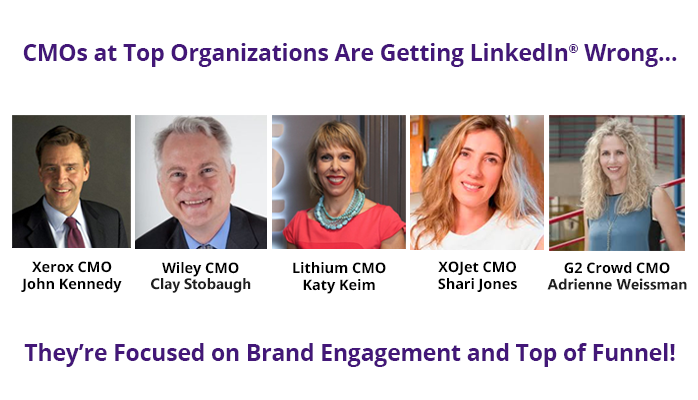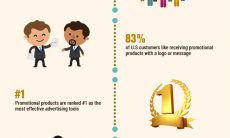Recent studies show 87% of B2B sales and marketing leaders are using LinkedIn and other social media platforms, but less than 1 in 5 can clearly prove and demonstrate social media ROI. I believe it’s because the attention and efforts are on the top of the funnel instead of thinking about the complete buyer’s journey.
A recent MarketingLand.com article, “5 CMOs Who Are Turning To LinkedIn,” shows how CMOs at Xerox, Lithium, Wiley, XOJet and G2 Crowd are focused on brand awareness and brand engagement instead of buyer engagement. Below I analyze their ideas, thoughts, and actions – and show you how they are focused on the top of the funnel.
Xerox is Focused on Reaching Prospects with their Content – not Engaging Prospects using Content
Xerox CMO John Kennedy mentioned that they are using LinkedIn to share content with their followers. Through company page updates and sponsored updates, Xerox is supplying their audience with e-books, SlideShare presentations, and blog articles that offer advice on how to work better. He stated that “hopefully, we’ll provide useful resources that can help those who follow us perform better; and as a result, engender interest in the Xerox brand along the way.”
That’s a lot of hopefuls. Hopefully, prospects will find and read Xerox’s content, hopefully, they will find it useful and hopefully, the content they read will generate interest in the Xerox brand in the process. You see, John is using the word “hopefully” because he cannot directly tie these LinkedIn actions to sales opportunities or even revenue.
Because they are just focused on reach and getting brand awareness, there is no predictive marketing. However, when you focus on the complete funnel and pay strict attention to the next step actions prospects are taking as you build the relationship, you can put a process in place that you know will lead to revenue.
Wiley is Focused on Click-Through Rates and Leads (Even if the Leads do not move further)
Wiley’s CMO, Clay Stobaugh, mentioned that they’re focused on sponsored updates and sponsored Inmails, since they are getting amazing click-through rates. He’s just focused on leads and getting people into the funnel. Focusing just on leads causes misaligned goals with sales (leads vs. revenue) and marketing teams optimizing for cost per lead rather than true business growth.
It seems like there is misalignment here, as Clay does not mention how many of the prospects who clicked through became paying customers, or how this paid media opportunity is driving real business growth.
Forrester reports that 99% of leads don’t convert, and LinkedIn says 87% of leads don’t convert. So it doesn’t matter how many clickthroughs are becoming leads if they are not moving forward. By focusing on the top of the funnel, you may get a low cost per lead, but your cost of business growth will be high (and that’s the metric that should count!)
Lithium is using LinkedIn to fill the Funnel and then letting Marketing Automation Programs take over
Their CMO, Kathy Keim, understands that the volume of leads from these updates are less than other social media platforms. And she says that marketers should spend less time on volume at the top of the funnel and more on what is driving through to a qualified sales opportunity. I totally agree with that, but I don’t agree with how Lithium is driving prospects to a qualified sales opportunity. They’re letting marketing automation programs take over once they get a prospect into the funnel using updates.
But what about those leads that are resistant to sales and marketing messages and do not want to move forward without a real relationship? What about those B2B buyers who are looking for vendors that can turn their vision into a clear path to value? You can only do that if you take the time to build a real relationship instead of treating prospects like a lead – which is exactly what you’re doing when you let your marketing automation take over.
By just using it for a top of the funnel tool (instead of using LinkedIn to directly engage and interact with their prospects on a 1-on-1 level to help grow relationships) Lithium is missing out on opportunities. Prospects are using LinkedIn throughout the complete buying process to make their buying decision, which means you should be thinking beyond the top of the funnel.
XOJET and G2Crowd is using LinkedIn for Brand Building and an Extension to their Website
XOJET CMO Shari Jones is currently utilizing LinkedIn for two core functions – brand building and recruitment. Their marketing efforts are concentrated on their company page – which is top of the funnel. She’s failing to understand that LinkedIn is not about engaging with brands! B2B buyers on LinkedIn are looking for access to broaden networks that can help them (not brands – but with actual visible experts) and they want relevant context to connect with those vendors.
G2 Crowd’s CMO, Adrienne Weissman, stated that they are using their LinkedIn company page as an extension to their website. On their company page, they are sharing relevant content with their followers and specific audiences.
These companies are taking the first step to building long-term value using LinkedIn. They are building a following and establishing their brand as an expert resource with the content they are sharing on their LinkedIn company page. But, building long-term value that leads to ROI and revenue requires further educating your prospects via a nurturing flow and real relationship building that has prospects comfortably moving forward.
These Marketing Leaders are not realizing the real power of LinkedIn:
“The Ability to Target Key Decision Makers, Build a Relationship and Leverage those Relationships to Transition these Prospects through each Stage of the Buying Cycle”
LinkedIn marketing is simply becoming a numbers game. My recent LinkedIn marketing study shows this. I asked sales and marketing leaders as well as some well-recognized, trusted social media marketing experts and firm owners: What metrics are most important to you? What are you paying attention to?
Most of the sales and marketing leaders and social media experts chose clicks, profile, and platform post views, website traffic, and superficial metrics like shares, comments, and likes. They chose these metrics over:
- Next step actions beyond the click, like, and comment
- Marketing qualified and sales qualified leads
- Revenue
That’s why most of the sales and marketing leaders were mainly getting visibility and reach, and that’s about it. The sales and marketing leaders who were regularly driving demand and creating sales opportunities (not leads, but actual opportunities that went past the initial interest stage) were focused on revenue objectives. They were focused on having the right tools, content, and processes to helped them meet revenue objectives using LinkedIn.
Remember, you can’t create a path to LinkedIn revenue and ROI if all of your focus is on: how much you expanded your network, how many people you’re reaching with your content and sales messages, and what your click-through rate is on sponsored updates. And, it’s time we focus on achieving revenue objectives. My recent webinar shows how to go from lead to revenue using LinkedIn. Click here to watch the on-demand webinar.




